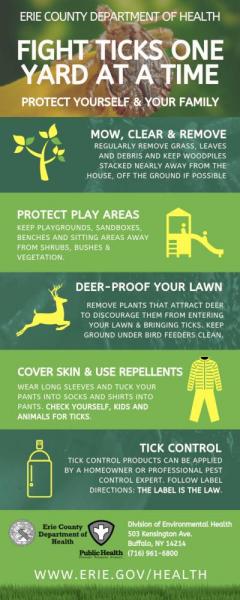Modified: April 15, 2019 1:32pm
Latest News
PRESS RELEASE
From the Office of the Commissioner of Health, Dr. Gale R. Burstein
Date: April 15, 2019
CONTACT: Kara Kane, Public Information Officer
Email: kara.kane@erie.gov
WARMER WEATHER ELEVATES RISKS FOR DISEASES SPREAD BY TICKS
Insects Transmit Bacteria, Viruses and Parasites That Can Cause Serious Illnesses Like Lyme Disease
ERIE COUNTY, NY— The Erie County Department of Health is preparing for warmer weather and the surge in the tick population.
“Ticks can expose people to tick-borne diseases,” said Health Commissioner Dr. Gale R. Burstein. “Lyme Disease is caused by bacteria and transmitted through bites from infected blacklegged ticks.” She continued, “Lyme Disease can affect people of any age, causing fever, headache, a bull’s-eye skin rash and other more serious complications.”
“Ticks are active from April through November in our region, depending on the weather,” said Senior Public Health Sanitarian Peter Tripi. “By the middle of the summer, young ticks (larvae) and adult ticks are seeking a blood meal from humans or animals like family pets.”
He continued, “Take steps to prevent tick bites by covering your skin and tucking long-sleeve shirts into pants and pants into socks. Tick larvae, active from mid-May through July, are the size of a poppy seed and difficult to see.”
Ticks can be extremely small, so a thorough inspection on yourself and your children of skin and clothing is necessary after gardening, camping, hiking, playing outdoors and other traditional summer activities. “If you find a tick on your skin, carefully remove the entire tick and observe for signs and symptoms of disease,” said Dr. Burstein. “Transfer of tick-borne illness like Lyme Disease depends on when the tick is feeding, how long it is attached and if it is removed properly. If you suspect a tick bite, consult your health care provider to review any symptoms.”
According to the Centers for Disease Control (CDC), Lyme Disease has accounted for up to 82 percent of tick-borne diseases in past seasons. Most cases of Lyme Disease can be treated in its early stages with antibiotics.
What Can I Do To Reduce Ticks In My Yard?
- Keep lawns mowed and edges trimmed
- Clear brush, leaf litter and tall grass around the house, and at the edges of gardens and stone walls
- Stack woodpiles neatly away from the house and preferably off the ground
- In the fall, clear your yard of all leaf and garden litter, where ticks can live in the winter
- Keep the ground under bird feeders clean so as not to attract small animals that can carry ticks into your yard
- Locate children's swing sets and other play equipment in sunny, dry areas of the yard, away from the woods where ticks can be abundant
- Using an approved insecticide once a year (in June) can significantly reduce tick numbers on a residential property
How Do I Protect Myself and Family?
- Avoid direct contact with ticks
- Avoid wooded and brushy areas with high grass and leaf litter.
- Walk in the center of trails: stay on cleared trails when walking or hiking, and avoid the edge habitat where ticks are likely to be.
- Repel ticks on exposed skin with repellent that contains 20 percent or more DEET, picaridin or IR3535. Do not use on children younger than two months. Use according to instructions on the label.
- Treat clothing, socks, shoes, boots, and camping gear with products that contain permethrin; do not use this on skin. It can remain protective through several washings. Pre-treated clothing is available and may be protective longer.
- Wear a long-sleeved shirt and long, light-colored pants tucked into socks or closed-toed shoes. Talk to your veterinarian about effective tick control options.
Find and Remove Ticks from Your Body
- Bathe or shower as soon as possible after coming indoors (preferably within two hours) to wash off and more easily find ticks that are crawling on you.
- Conduct a full-body tick check using a hand-held or full-length mirror to view all parts of your body upon return from tick-infested areas. Parents should check their children for ticks under the arms, in and around the ears, inside the belly button, behind the knees, between the legs, around the waist, and especially in their hair.
- Examine gear and pets. Ticks can ride into the home on clothing and pets, then attach to a person later, so carefully examine pets, coats, and day packs.
- Tumble dry clothes in a dryer on high heat for 10 minutes to kill ticks on dry clothing after you come indoors. If the clothes are damp, additional time may be needed. If the clothes require washing first, hot water is recommended. Cold and medium temperature water will not kill ticks effectively. If the clothes cannot be washed in hot water, tumble dry on low heat for 90 minutes or high heat for 60 minutes. The clothes should be warm and completely dry.
#
For More Information:
- Erie County Department of Health – Ticks and Lyme Disease: http://www2.erie.gov/health/index.php?q=ticks-lyme-disease
- New York State Department of Health-General Information about Lyme disease & Tick Bite Prevention: https://www.health.ny.gov/publications/2813/
- New York State Department of Health Information about Tick Repellent: Dress to Repel: https://www.health.ny.gov/environmental/pests/dress_to_repel.htm
- Centers for Disease Control and Prevention-Ticks: https://www.cdc.gov/lyme/index.html
- Environmental Protection Agency-Select Proper Insect Repellant: https://www.epa.gov/insect-repellents
###


